|
We cooked for charter for eight years aboard my first boat Whisper, a CSY 44 walk-over, without making any significant changes to her galley. WHISPER's galley faced aft to the cockpit across the back end of the salon, sink, counter and stove to port, huge three box fridge and freezer to starboard. Since almost all of our cooking was done at anchor, it didn't matter that the galley was so open. For underway, I had a galley strap that kept my butt in the corner between sink and stove. It's not that I loved it the way it was, but because the boats were designed for the charter trade, it was very functional.
The biggest change I did make to WHISPER was a greatly enlarged cockpit table without fiddles where I could seat up to 4 people. Charter dining was a situation that doesn't really call for fiddles, although truthfully, I'm not a big fan of fiddles on cockpit tables even while out cruising. My experience has been the fiddles are more likely to LAUNCH a sliding glass or bowl into a flip. Rubber non-skid placemats really did the trick for us when needed.
When I moved aboard TACKLESS II, a CSY Walk-thru, to go cruising, the focus changed. We were thinking longer term. And we were thinking home. Don and I did a big refit on the boat in Trinidad after our first five-month cruise south from the Virgins, prior to our taking off for what became a nine-year year cruise through Central America, Ecuador, Mexico and across the Pacific to Australia. One of the main focuses of the refit was the galley.
Refrigeration
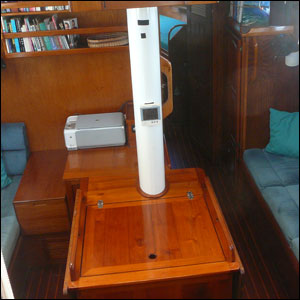 |
We added a separate self-contained
freezer under the table in the salon, concealed under the lift-up "door". |
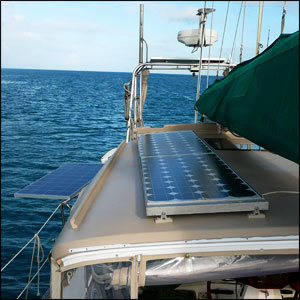 |
| We added more solar panels to power the new refrigeration system |
A CSY 44 walk-thru, Tackless had a Pullman style galley in the starboard pass thru. She had a pair of over-under front-loading boxes for refrigerator and freezer. This is a great arrangement at anchor, but had some negatives when underway, particularly the freezer unit which collected condensate from the fridge and from which it was hard to excavate what you wanted without everything (not to mention the cold) falling out.
Also the boxes were originally fitted with engine-drive refrigeration and holding plates. We were concerned about the hours on our middle-aged engine and the flexibility we would have to leave the boat unattended for inland travel.
So, we added air-cooled Adler Barbour units to each box -- a horizontal evaporator in the upper box (which could serve as a freezer at the dock or on the hard and which allowed us to make ice in standard trays) and an Adler Barbour cold plate in the top of the freezer section. Our thinking was that this would allow us to alternate between engine-drive and 12-volt as the situation warranted.
THEN we added a 60-liter Minus 40 chest freezer into the center of the salon and rebuilt the salon table around it. This turned out to be a fabulous piece of equipment (once we got the right gauge cable to serve it). Very efficient.
We ended up primarily using the upper fridge box with the Minus 40 freezer and only ran the lower freezer when planning a long time away from civilization (the Pacific crossing) or when it was time to defrost one of the other boxes.
We added more solar panels to the hard top, arch and the two quarter rails of the aft deck (for a total of 7 panels producing 570 watts) to power all this (not to mention our computers!)
As it turned out, we found the 12-volt air-cooled system so satisfactory we didn't run the engine-drive system often enough to keep its compressor seals in good shape. Eventually, we took the whole engine-drive system out to free up more space on the engine.
Appliances
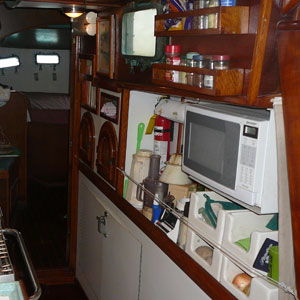 |
|
Galley aft inboard shelf |
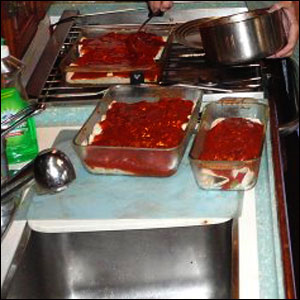 |
|
Cutting board fitting over half of the sink |
We also mounted a microwave under the cockpit deck and had custom nesting box-shelves made to hold onions, potatoes and tomatoes. On the narrow ledge under the cockpit we set up all the electrical appliances that had been so crucial during charter, blender, small food processor, coffee grinder.
I continued to use these items when cruising, although less often. Double sink & Corian-type countertops
To top things off we put in a new, deeper stainless steel Skandik double sink, a standard household pull-out sprayer faucet (wonderful) and new countertops of a molded Corian-type product called Decoran which allowed us to build up backsplashes on all edges including the front fiddle to protect the white oak wood work from water stains.
We had a full-sized insert from the Decoran made to fit over the sink thinking it would be useful for more counter space for kneading bread. At the same time, we made a cutting board out of starboard to fit over half of the sink opening enabling us to slide it from side to side, even underway. This was very useful. To my surprise, I hardly ever used the full insert.
Macerator for the Galley Sink
We also added a macerator in the galley sink exhaust line. Previously, because the drains were right at water level, the sinks backfilled on a port tack and gurgled at anchor. The macerator solved this problem and evacuated the dirty dishwater completely. Lighting
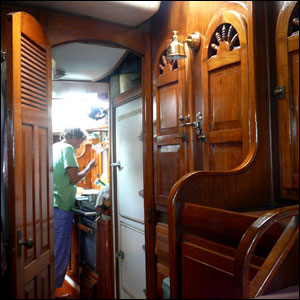 |
|
The locker we converted to a pantry and the double door fridge |
We increased the light available in the galley area by installing a four- way (two power, red/white) Alpenglow light over the stove and sink area. This is a great fixture, and the red light option was useful on passages.
The passageway space in front of the fridge narrows down, so we changed the overhead liner from wood to white Formica and moved one of the leftover headlight style fixtures to in front of the refrigerator. With the white overhead reflecting extra light, this brightened up the fridge area significantly. We should have just put another Alpenglow fixture there. (We LOVED Alpenglows. Had the cabin lights throughout the boat, too.)
Storage
Lastly, we converted a hanging locker on the starboard side to hold canned goods nearer to the galley, but also to help with weight distribution on the boat.
Cockpit Dining Area
The cockpit was our most important space on Tackless II. The hardtop with built-in reading lights and Isinglass enclosure (an addition we made at the same time as the galley refit) turned the cockpit into a completely new room. Not only did we do our sailing there, we did all our lounging and dining there, especially as Tackless II’s remodeled salon table was very hard to squeeze in around when the table leaves were raised.
So, the other important addition to the cockpit was a handsome teak table that folded away against the binnacle. When raised and opened out it again allowed us to seat four people for a meal. We never once missed the original small table with its uncomfortable fiddles. |